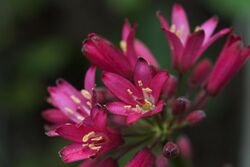Biology:Clintonia andrewsiana
| Clintonia andrewsiana | |
|---|---|

| |
| Sonoma County, California (May 2010) | |
| Scientific classification | |
| Kingdom: | Plantae |
| Clade: | Tracheophytes |
| Clade: | Angiosperms |
| Clade: | Monocots |
| Order: | Liliales |
| Family: | Liliaceae |
| Subfamily: | Lilioideae |
| Genus: | Clintonia |
| Species: | C. andrewsiana
|
| Binomial name | |
| Clintonia andrewsiana | |
| Synonyms[2] | |
| |
Clintonia andrewsiana is a species of flowering plant in the lily family Liliaceae. The species was discovered by John Milton Bigelow in 1854 and described by John Torrey in 1856.[3] The specific epithet andrewsiana honors Timothy Langdon Andrews (1819–1908),[4] a "gentleman who assiduously examined the botany" of California during the mid-19th century. The species is commonly known as Andrews clintonia or red clintonia,[5][6] where the latter refers to the color of the flowers. In California, it is also known as bluebead lily or western bluebead lily,[7][8] not to be confused with C. borealis, which is likewise known as bluebead lily. The Pomo people of northern California considered the plant to be poisonous.[9]
Description
Clintonia andrewsiana is a perennial herbaceous plant that spreads by means of underground rhizomes. It is the largest plant species in the genus, standing 30 to 80 cm (12 to 31 in) tall. Around the base of the plant are 5 or 6 oval-shaped, dark green leaves, each 20 to 35 cm (8 to 14 in) long and 5 to 15 cm (2 to 6 in) wide. The tall, erect inflorescence consists of a terminal umbel with 10–20 flowers and up to three lateral umbels with 2–4 flowers each. Each flower has six pink to reddish-purple tepals 1 to 2 cm (0.4 to 0.8 in) long and six stamens about half as long as the tepals. The fruit is a blue or blue-black berry approximately 1 cm (0.4 in) in diameter.[6][10]
Distribution and habitat
Clintonia andrewsiana is found along the West Coast of the United States, from Monterey County in central California north to Curry County in southwestern Oregon.[11] It prefers the shady, moist areas of the coastal redwood forests.[6]
The range of C. andrewsiana overlaps with that of C. uniflora in Humboldt County and Del Norte County in northwestern California and Curry County in Oregon,[11][12] but the two species are readily distinguished by their flowers. C. andrewsiana has multiple flowers arranged in one or more umbels while C. uniflora has a single flower with white tepals.[10] The tepals of C. andrewsiana are a deep claret red.
See also
- Bead lily
- Bluebead (disambiguation)
- List of plants known as lily
References
- ↑ "Clintonia andrewsiana". NatureServe, Arlington, Virginia. https://explorer.natureserve.org/Taxon/ELEMENT_GLOBAL.2.153737/Clintonia_andrewsiana. Retrieved 1 September 2020.
- ↑ "Clintonia andrewsiana Torr.". Royal Botanic Gardens, Kew. https://powo.science.kew.org/taxon/urn:lsid:ipni.org:names:533155-1. Retrieved 5 August 2020.
- ↑ Torrey, John (1856), Report on the botany of the expedition (Part V), Description of the general botanical collections (No. 4), Explorations and Surveys for a Railroad Route from the Mississippi River to the Pacific Ocean, IV: Route near the thirty-fifth parallel, explored by lieutenant A. W. Whipple, topographical engineers, in 1853 and 1854, Washington, D.C.: Department of War, pp. 150-151, doi:10.5962/bhl.title.41563, OCLC 12125612, https://www.biodiversitylibrary.org/item/100867#page/183/mode/1up, retrieved 4 March 2022
- ↑ Daniel, Thomas F. (May 16, 2008). "One Hundred and Fifty Years of Botany at the California Academy of Sciences (1853–2003)". Proceedings of the California Academy of Sciences. 4 59 (7): 215–305. https://www.calacademy.org/sites/default/files/assets/docs/pdf/history_botany_at_cas_pcas_v59apr08_daniel_pp_215-305lr.pdf. Retrieved 22 August 2020.
- ↑ "Clintonia andrewsiana". Natural Resources Conservation Service PLANTS Database. USDA. https://plants.usda.gov/core/profile?symbol=CLAN2. Retrieved 22 August 2020.
- ↑ 6.0 6.1 6.2 Utech, Frederick H. (2002), "Clintonia andrewsiana", in Flora of North America Editorial Committee, Flora of North America North of Mexico (FNA), 26, New York and Oxford, http://www.efloras.org/florataxon.aspx?flora_id=1&taxon_id=242101529, retrieved 21 August 2020
- ↑ "Clintonia andrewsiana Torr.". https://www.calflora.org//cgi-bin/species_query.cgi?where-taxon=Clintonia+andrewsiana. Retrieved 2 September 2020.
- ↑ Painter, Elizabeth (May 1, 2016). "Common (vernacular) names applied to California vascular plants". https://ucjeps.berkeley.edu/cgi-bin/get_painter_common.pl?19850. Retrieved 2 September 2020.
- ↑ "Clintonia andrewsiana Torr.". http://naeb.brit.org/uses/species/1030/. Retrieved 15 October 2020.
- ↑ 10.0 10.1 McNeal, Dale W. (2012), "Clintonia andrewsiana", in Jepson Flora Project, Jepson eFlora, The Jepson Herbarium, University of California, Berkeley, http://ucjeps.berkeley.edu/eflora/eflora_display.php?tid=19850, retrieved 21 August 2020
- ↑ 11.0 11.1 " Clintonia andrewsiana", County-level distribution map from the North American Plant Atlas (NAPA) (Biota of North America Program (BONAP)), 2014, http://bonap.net/MapGallery/County/Clintonia%20andrewsiana.png, retrieved 21 August 2020
- ↑ " Clintonia uniflora", County-level distribution map from the North American Plant Atlas (NAPA) (Biota of North America Program (BONAP)), 2014, http://bonap.net/MapGallery/County/Clintonia%20uniflora.png, retrieved 4 August 2020
External links
| Wikimedia Commons has media related to: |
- "Photo gallery: Clintonia andrewsiana". Regents of the University of California, Berkeley. 2012. https://calphotos.berkeley.edu/cgi-bin/img_query?rel-taxon=begins+with&where-taxon=Clintonia+andrewsiana. Retrieved 22 August 2020.
- "Clintonia andrewsiana". University of Texas at Austin. https://www.wildflower.org/plants/result.php?id_plant=CLAN2. Retrieved 22 August 2020.
Wikidata ☰ Q5134293 entry
 |




